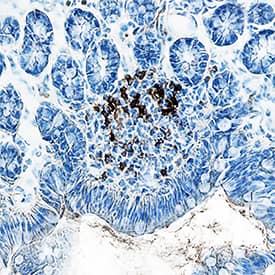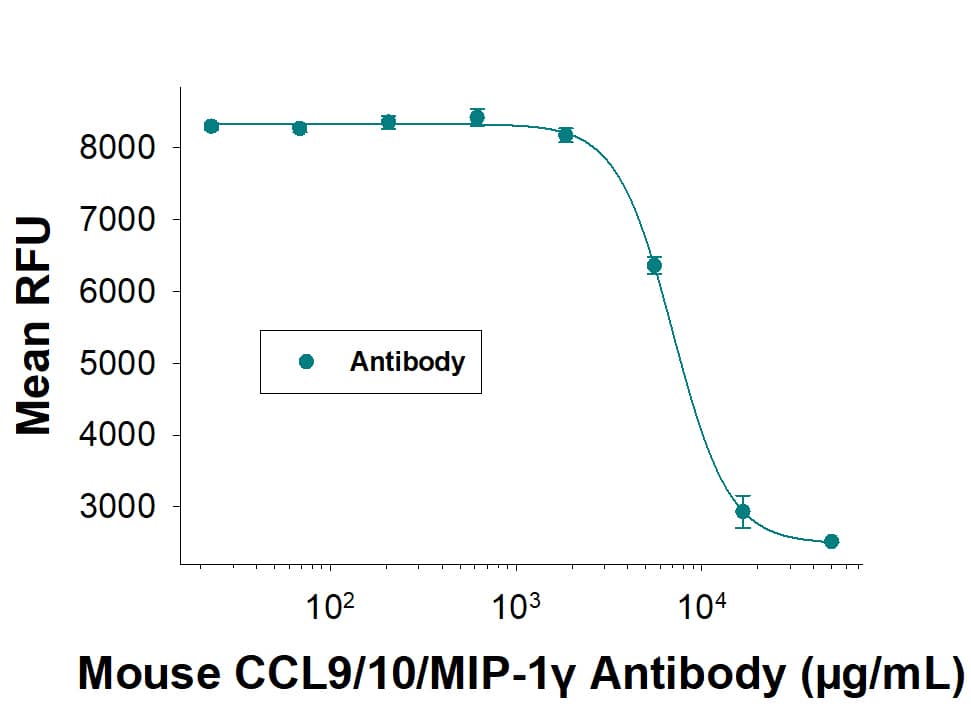Mouse CCL19/MIP-3 beta Antibody Summary
Gly26-Val107 (Ser108LeuGlu)
Accession # Q548P0
Customers also Viewed
Applications
Please Note: Optimal dilutions should be determined by each laboratory for each application. General Protocols are available in the Technical Information section on our website.
Scientific Data
 View Larger
View Larger
Chemotaxis Induced by CCL19/MIP‑3 beta and Neutralization by Mouse CCL19/MIP‑3 beta Antibody. Recombinant Mouse CCL19/MIP-3 beta (Catalog # 440-M3) chemoattracts the BaF3 mouse pro-B cell line transfected with human CCR7 in a dose-dependent manner (orange line). The amount of cells that migrated through to the lower chemotaxis chamber was measured by Resazurin (Catalog # AR002). Chemotaxis elicited by Recombinant Mouse CCL19/MIP-3 beta (50 ng/mL) is neutralized (green line) by increasing concentrations of Goat Anti-Mouse CCL19/MIP-3 beta Antigen Affinity-purified Polyclonal Antibody (Catalog # AF880). The ND50 is typically 0.8-4 µg/mL.
 View Larger
View Larger
CCL19/MIP‑3 beta in Mouse Splenocytes. CCL19/MIP-3 beta was detected in immersion fixed mouse splenocytes using Goat Anti-Mouse CCL19/MIP-3 beta Antigen Affinity-purified Polyclonal Antibody (Catalog # AF880) at 10 µg/mL for 3 hours at room temperature. Cells were stained using the NorthernLights™ 557-conjugated Anti-Goat IgG Secondary Antibody (yellow; Catalog # NL001) and counterstained with DAPI (blue). View our protocol for Fluorescent ICC Staining of Non-adherent Cells.
 View Larger
View Larger
CCL19/MIP‑3 beta in Mouse Dendritic Cells. CCL19/MIP-3 beta was detected in immersion fixed mouse dendritic cells using Goat Anti-Mouse CCL19/MIP-3 beta Antigen Affinity-purified Polyclonal Antibody (Catalog # AF880) at 10 µg/mL for 3 hours at room temperature. Cells were stained using the NorthernLights™ 557-conjugated Anti-Goat IgG Secondary Antibody (red; Catalog # NL001) and counterstained with DAPI (blue). View our protocol for Fluorescent ICC Staining of Non-adherent Cells.
Preparation and Storage
- 12 months from date of receipt, -20 to -70 °C as supplied.
- 1 month, 2 to 8 °C under sterile conditions after reconstitution.
- 6 months, -20 to -70 °C under sterile conditions after reconstitution.
Background: CCL19/MIP-3 beta
CCL19/MIP-3 beta, also known as ELC (EBI1-Ligand Chemokine), is a reported beta chemokine that binds specifically to the chemokine receptor CCR-7/EBI-1/BLR-2. Mouse (human) MIP-3 beta cDNA encodes a 108 (98) amino acid residue precursor protein with a predicted 25 (21) aa residue signal peptide that is cleaved to form the 83 (77) aa residue mature secreted protein. MIP-3 beta is distantly related to other beta chemokines (20-30% aa sequence identity). Mouse MIP-3 beta shares 83% aa sequence homology with human MIP-3 beta. MIP-3 beta has been shown to be constitutively expressed in various lymphoid tissues (including thymus, lymph nodes, appendix, and spleen) in dendritic cells within the T cell zone. The expression of MIP-3 beta is down-regulated by the anti-inflammatory cytokine IL-10. Recombinant MIP-3 beta has been shown to be chemotactic for T cells and B cells. The MIP-3 beta receptor (CCR7/EBI-1/BLR-2) is expressed in various lymphoid tissues and activated B and T lymphocytes. CCR7 is also strongly up-regulated in B cells infected with Epstein-Barr virus and T cells infected with herpes virus 6 or 7.
- Kim, C.H. et al. (1998) J. Immunol. 160:2418.
- Ngo, V.N. et al. (1998) J. Exp. Med. 188:181.
- Rossi, D.L. et al. (1997) J. Immunol. 158:1033.
- Yoshida, R. et al. (1997) J. Biol. Chem. 272:13803.
Product Datasheets
Citations for Mouse CCL19/MIP-3 beta Antibody
R&D Systems personnel manually curate a database that contains references using R&D Systems products. The data collected includes not only links to publications in PubMed, but also provides information about sample types, species, and experimental conditions.
15
Citations: Showing 1 - 10
Filter your results:
Filter by:
-
Glycosyltransferase Extl1 promotes CCR7-mediated dendritic cell migration to restrain infection and autoimmunity
Authors: J Liu, Y Cheng, X Zhang, Y Chen, H Zhu, K Chen, S Liu, Z Li, X Cao
Cell Reports, 2023-01-18;42(1):111991.
Species: Mouse
Sample Types: Whole Cells
Applications: Flow Cytometry -
Treg tissue stability depends on lymphotoxin beta-receptor- and adenosine-receptor-driven lymphatic endothelial cell responses
Authors: V Saxena, W Piao, L Li, C Paluskievi, Y Xiong, T Simon, R Lakhan, CC Brinkman, S Walden, KL Hippen, M WillsonShi, YS Lee, C Wagner, BR Blazar, JS Bromberg
Cell Reports, 2022-04-19;39(3):110727.
Species: Mouse
Sample Types: Whole Tissue
Applications: IHC -
Inflammation rapidly recruits mammalian GMP and MDP from bone marrow into regional lymphatics
Authors: Juana Serrano-Lopez, Shailaja Hegde, Sachin Kumar, Josefina Serrano, Jing Fang, Ashley M Wellendorf et al.
eLife
-
Embryonic FAP+ lymphoid tissue organizer cells generate the reticular network of adult lymph nodes
Authors: Alice E. Denton, Edward J. Carr, Lukasz P. Magiera, Andrew J.B. Watts, Douglas T. Fearon
Journal of Experimental Medicine
-
Chronic Inflammation Directs an Olfactory Stem Cell Functional Switch from Neuroregeneration to Immune Defense
Authors: M Chen, RR Reed, AP Lane
Cell Stem Cell, 2019-09-12;25(4):501-513.e5.
Species: Mouse
Sample Types: In Vivo, Whole Tissue
Applications: IHC-Fr, Neutralization -
CCR7-CCL19/CCL21 Axis is Essential for Effective Arteriogenesis in a Murine Model of Hindlimb Ischemia
Authors: AY Nossent, AJ Bastiaanse, EA Peters, MR de Vries, Z Aref, SM Welten, SC de Jager, TC van der Po, PH Quax
J Am Heart Assoc, 2017-03-08;6(3):.
Species: Mouse
Sample Types: Whole Tissue
Applications: IHC-Fr -
Heterogeneous fibroblasts underlie age-dependent tertiary lymphoid tissues in the kidney
Authors: Yuki Sato, Akiko Mii, Yoko Hamazaki, Harumi Fujita, Hirosuke Nakata, Kyoko Masuda et al.
JCI Insight
-
Graft Site Microenvironment Determines Dendritic Cell Trafficking Through the CCR7-CCL19/21 Axis
Authors: Jing Hua, William Stevenson, Thomas H. Dohlman, Takenori Inomata, Maryam Tahvildari, Narghes Calcagno et al.
Investigative Opthalmology & Visual Science
-
Deficiency of lymph node-resident dendritic cells (DCs) and dysregulation of DC chemoattractants in a malnourished mouse model of Leishmania donovani infection.
Authors: Ibrahim M, Barnes J, Osorio E, Anstead G, Jimenez F, Osterholzer J, Travi B, Ahuja S, White A, Melby P
Infect Immun, 2014-05-12;82(8):3098-112.
Species: Mouse
Sample Types: Whole Tissue
Applications: IHC -
CCR2 plays a critical role in dendritic cell maturation: possible role of CCL2 and NF-kappa B.
Authors: Jimenez F, Quinones MP, Martinez HG, Estrada CA, Clark K, Garavito E, Ibarra J, Melby PC, Ahuja SS
J. Immunol., 2010-04-19;184(10):5571-81.
Species: Mouse
Sample Types: In Vivo
Applications: Neutralization -
Comprehensive assessment of chemokine expression profiles by flow cytometry.
Authors: Eberlein J, Nguyen TT, Victorino F, Golden-Mason L, Rosen HR, Homann D
J. Clin. Invest., 2010-02-08;120(3):907-23.
Species: Mouse
Sample Types: Whole Cells
Applications: Flow Cytometry -
CCR7 modulates pulmonary and lymph node inflammatory responses in cigarette smoke-exposed mice.
Authors: Demoor T, Bracke KR, Vermaelen KY, Dupont L, Joos GF, Brusselle GG
J. Immunol., 2009-12-15;183(12):8186-94.
Species: Mouse
Sample Types: Whole Tissue
Applications: IHC-P -
CCR7-CCL19/CCL21-regulated dendritic cells are responsible for effectiveness of sublingual vaccination.
Authors: Song JH, Kim JI, Kwon HJ, Shim DH, Parajuli N, Cuburu N, Czerkinsky C, Kweon MN
J. Immunol., 2009-06-01;182(11):6851-60.
Species: Mouse
Sample Types: In Vivo
Applications: Neutralization -
CCR7 ligands stimulate the intranodal motility of T lymphocytes in vivo.
Authors: Worbs T, Mempel TR, Bolter J, von Andrian UH, Forster R
J. Exp. Med., 2007-02-26;204(3):489-95.
Species: Mouse
Sample Types: Whole Tissue
Applications: IHC-Fr -
Defective CCR7 expression on dendritic cells contributes to the development of visceral leishmaniasis.
Authors: Ato M, Stager S, Engwerda CR, Kaye PM
Nat. Immunol., 2002-11-18;3(12):1185-91.
Species: Mouse
Sample Types: Whole Tissue
Applications: IHC-Fr
FAQs
No product specific FAQs exist for this product, however you may
View all Antibody FAQsIsotype Controls
Reconstitution Buffers
Secondary Antibodies
Reviews for Mouse CCL19/MIP-3 beta Antibody
Average Rating: 4 (Based on 1 Review)
Have you used Mouse CCL19/MIP-3 beta Antibody?
Submit a review and receive an Amazon gift card.
$25/€18/£15/$25CAN/¥75 Yuan/¥2500 Yen for a review with an image
$10/€7/£6/$10 CAD/¥70 Yuan/¥1110 Yen for a review without an image
Filter by:

















